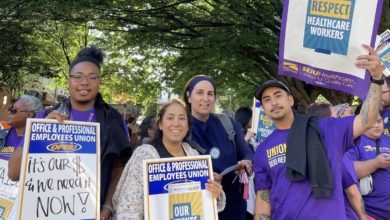The United States has the largest health expenditures per capita of any country in the world—16 percent of the U.S. gross domestic product. Yet, the number of U.S. residents lacking adequate health care is on the rise.
Forty-seven million people do not have health insurance. Nearly all uninsured are workers, working-class families or
 |
A study produced by Harvard Medical School in 2006 illustrates an alarming class divide concerning access to health care. “After taking into account income, age sex, race and immigrant status, poor U.S. residents (making less than $25,000 per year) were 2.6 times less likely to have a regular doctor than someone making $70,000 or more per year.”
Many U.S. residents report going without needed medical care due to high cost. Too often the trade off for having health insurance is having deep financial woes. In 2001, just under half of all bankruptcies in the United States—approximately 1.9 to 2.2 million—were caused by costs associated with prolonged illness or injury.
“These findings raise serious questions about what we’re getting for the 2.1 trillion we’re spending on health care this year,” stated Dr. David Himmelstein Associate Professor of Medicine at Harvard.
What workers are getting is not much. Under the capitalist system, health care is a commodity from which corporations make profits. It is not considered a basic human right.
Privatized care
The commodification of health is most evident in the drive to privatize the health care industry.
In the United States, investor-owned firms have come to dominate renal dialysis, nursing home care, inpatient psychiatric and rehabilitation facilities and health maintenance organizations (HMOs). Investor-owned firms represent 13 percent of all acute care facilities.
When a person enters a for-profit healthcare institution, they can expect to pay 19 percent more than at a non-profit facility. The choice of care facilities is often not up to the patient. It depends what is available in the nearby community.
Investor-owned healthcare institutions are most concerned with profits, not quality care. According to the Harvard study, “for-profit hospitals and dialysis clinics have higher death rates, and private nursing homes are more frequently cited for quality deficiencies and provide less nursing care, and investor-owned hospices provide less care to the dying.”
All over the United States, for-profit specialty hospitals offering only cardiac care not only duplicate services available at local general hospitals, but they also allow investor-run healthcare corporations to avoid building and maintaining money-losing programs such as geriatric care and emergency rooms—the most common entry points for uninsured patients.
Private healthcare firms often claim that we live in an era of limited resources, which is far from the truth. Resources are less limited now than ever before in human history. There is the ability to provide healthcare coverage for everyone in the United States.
It is the capitalist system, which places profits above human needs, that denies advanced technology and resources to tens of millions of people.
According to a 2002 Physicians for National Health Plan Newsletter article, hospitals and sophisticated equipment abound across the country. Even many rural areas boast of well-equipped facilities. Most U.S. physicians and nurses are superbly trained and dedicated to serve patients, research output is prodigious and health care is far more generously funded than in any other nation.
Yet, “the world’s richest health care system is unable to assure such basics as prenatal care and immunizations, and we trail most of the developed world on such indicators as infant mortality and life expectancy.”
Selective insurance
In its incessant drive for profits, the healthcare industry selects patients who will save it money.
Health insurers have wide latitude in choosing who they will insure and who they will deny coverage. Health insurance companies in many states, including California, can refuse to insure people if they are deemed to be “high-risk.” This means that the potentially insured may cost the companies more than they earn from them.
Who is “high-risk?” A recent Los Angeles Times report shed some light on this. In one case, a 27-year-old woman in “excellent health” was rejected for coverage by health insurance companies because she had sought psychological help for three months after ending an intimate relationship. This is only one example among many thousands.
The strategies employed by healthcare capitalists have nothing to do with providing real care for anyone. They are only meant to bolster profits by any means necessary.






